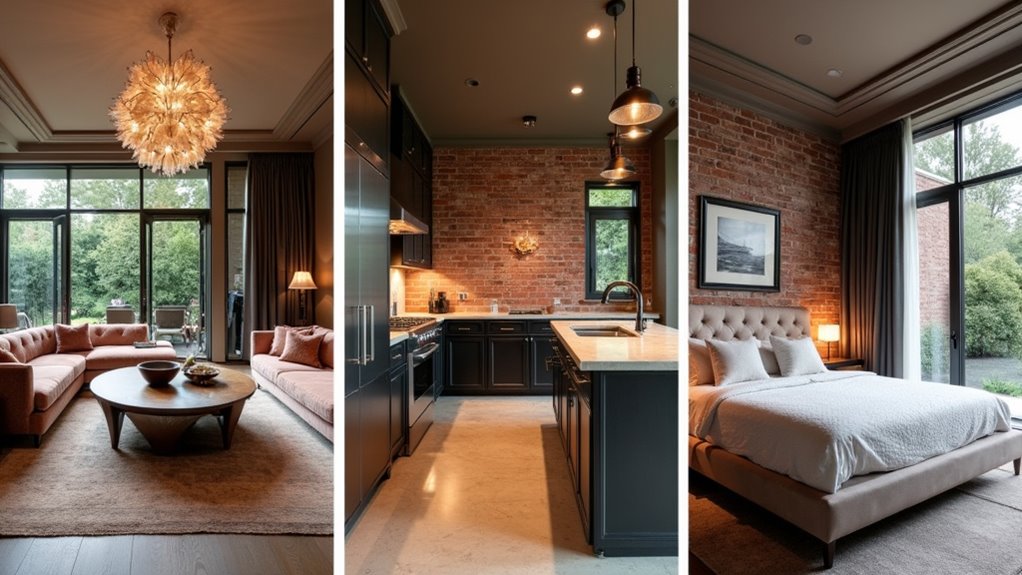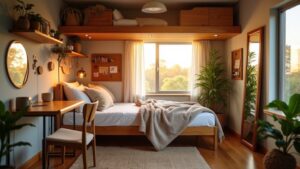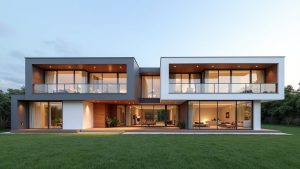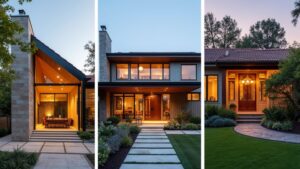Three stunning interior design ideas can transform any home into a sanctuary. First, biophilic design melds nature and indoor spaces, enhancing well-being with greenery and natural light. Second, the modern farmhouse aesthetic combines rustic charm and contemporary elegance, perfect for inviting atmospheres. Lastly, minimalism embodies the “less is more” philosophy, fostering serenity through simplicity and functional decor. Each approach offers unique benefits that elevate living spaces, leaving one curious for more insights on these transformative styles.
Key Takeaways
- Integrate biophilic design elements like indoor gardens and natural materials to promote well-being and tranquility.
- Embrace a modern farmhouse aesthetic by combining rustic charm with contemporary finishes for inviting and functional spaces.
- Utilize minimalist principles to create serene retreats that prioritize functionality and clean lines, enhancing intentional living.
- Maximize natural light and open floor plans to enhance spatial relationships and create a more spacious feel in your home.
- Incorporate vintage-inspired pieces with modern aesthetics to celebrate history while achieving a cohesive and harmonious atmosphere.
Biophilic Design – Integrating Nature

Although modern architecture often emphasizes sleek lines and minimalist aesthetics, biophilic design boldly reintroduces the organic elements of nature into interior spaces. This innovative approach embraces natural materials, transforming homes into havens of tranquility through the installation of indoor gardens and water features. Bamboo structures are integrated to enhance structural durability, combining modern aesthetics with sustainable living practices.
By incorporating curved forms reminiscent of nature, such as vaulted ceilings and organic countertops, biophilic design creates subconscious connections that evoke serenity. The strategic use of natural light maximizes spatial relationships, enhancing the interplay of light and shadow. Furthermore, the presence of greenery not only purifies indoor air but also fosters mental well-being, lowering stress and enhancing productivity, evident in the fact that biophilic design promotes improved well-being. Additionally, incorporating direct elements like water features can further enhance the tranquility of a space. Natural materials such as wood and stone add warmth and texture, further reinforcing the connection to nature. Ultimately, biophilic design celebrates the beauty of the natural world, inviting it seamlessly into daily life.
Modern Farmhouse – Rustic Meets Contemporary

The modern farmhouse aesthetic marries the rustic charm of traditional designs with the sleek elegance of contemporary style, creating inviting and functional spaces that resonate with warmth.
This design ethos embodies three core principles:
- Blend of Textures: Combining rustic textures, such as reclaimed wood and woven baskets, with modern finishes like stainless steel and polished stone creates visual intrigue. Using sustainable building materials further enhances the environmental impact, creating a fusion that respects both style and conservation.
- Open Flow: Emphasizing open floor plans promotes seamless transitions between kitchen, living, and dining areas while enhancing indoor-outdoor connectivity.
- Timeless Elements: The fusion of vintage-inspired pieces with clean, contemporary lines generates a balanced, cohesive atmosphere, ensuring a cozy feel without clutter.
Additionally, incorporating exposed concrete, natural wood, and stone veneer from Modern Facades With Natural Texture adds a touch of textural harmony and dimension to the design.
This approach not only cultivates an inviting environment but also celebrates both history and modernity harmoniously.
Minimalism – Simplicity and Functionality

Embracing the philosophy of “less is more,” minimalism transforms spaces into serene retreats where simplicity reigns supreme. This design approach prioritizes minimalist aesthetics, stripping away unnecessary elements to focus solely on essential features that serve a clear purpose.
Functional decor is at the heart of minimalism, where each piece of furniture is not only aesthetically pleasing but also multifunctional, ensuring usability without clutter. Clean lines, a neutral color palette, and generous use of negative space create an inviting atmosphere infused with tranquility.
Natural materials like wood and stone enhance the innate beauty of the design, while thoughtful use of light fosters an environment of clarity and calm. Ultimately, minimalism cultivates mindfulness and intentional living, encouraging appreciation for simplicity.






